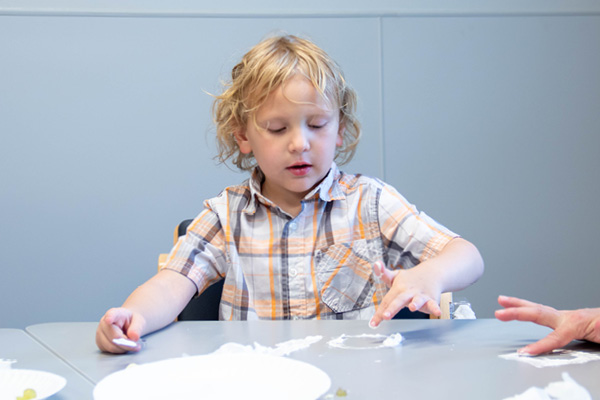3 MIN READ
My child is having a meltdown. What do I do?
By: Missy Songer, Behavioral Services Manager and Ashley Dysarz, Director of Behavioral Services

It is common for a person impacted by autism to experience meltdowns. As a parent, it is distressing, as well as mentally tiring, and can be physically challenging. Most parents of children with autism do everything they can to avoid new or unexpected circumstances that may instigate overload that could lead to a meltdown. If this sounds familiar, know that you are not alone.
Understanding what a meltdown is, can be helpful to parents. Then you are able to gain the ability to foresee the signs of a meltdown, as well as identify the causes, and reduce the frequency.
What is a meltdown?
A meltdown is an intense response to overwhelming circumstances—a complete loss of behavioral control. People with autism often have difficulty expressing themselves when they are feeling overly anxious or overwhelmed, which leads to an involuntary coping mechanism—a meltdown.
Meltdowns Compared to Temper Tantrums
Knowing the difference between a typical temper tantrum in a young child and a meltdown in a person with autism helps to further understand what a meltdown is.
Children have temper tantrums with intention and purpose. They use it as a way to gain access to an item or activity, to escape a task or demand, or as a call for attention. A child having a temper tantrum does have control over themselves, even if the tantrum results in attacking people, loud screaming, or breaking things.
A person having a meltdown typically screams, attacks people, hurts themselves and breaks things, which may look like a temper tantrum, but there is no underlying intention or plan involved.
When an individual impacted by autism has a meltdown, the person is not aware of self-control, as they are in the throes of distress, and typically the meltdown situation will have to calm itself down, meaning, it cannot simply be “turned off.”
What can I do during a meltdown?
- Stop trying to reason with your child during a meltdown. Their brain in this moment will not allow them to reason. They will not hear you at this point. Any attempt to reason may further escalate your child.
- Provide your child with some options of activities that will encourage them to relax. Utilize a visual and allow them to select a calming activity. Here are some free, printable calm down choice cards.
- Look at your reaction to your child’s meltdown. Your reaction will either escalate or deescalate the situation. It is OK to walk away and take a few deep breaths as long as they are not harming themselves or others. Reset yourself before intervening on the situation. Respect personal space.
- Try to distract and redirect your child in the early stages of a meltdown. When your child is showing signs of a possible meltdown, consider changing their environment or activity. Move from one room to another, redirect to a different activity, or go outside.
- Have a way for your child to communicate to you during their meltdown. Do they have a communication device to tell you what they need? Are they hungry? Are they scared? Having a way to communicate may help you understand the reason behind the meltdown. Here is a free resource with many different communication board options.
- Attempt to get your child to engage in movement during a meltdown. Movement naturally decreases stress and releases dopamine and endorphins in your brain that help you feel good. Encourage your child to jump on a trampoline, swing, run in place, play tag, etc.
- Look at the environment. Is it overstimulating? The environment may have triggered the meltdown. Try turning off the TV, turning down loud music or shutting off lights. Consider creating a calm-down corner in your home where your child can go when they are feeling overwhelmed. Have sensory items in the area. Teach your child to remove themselves and go to their calm down area on their own. It is important to practice using the calm down area when they are calm, not when they are in a heightened state of escalation. For ideas on how to create a calm down space, check out this link.
- Do anything that encourages deep breathing. Blow out imaginary candles. Blow on a pinwheel. Teach these strategies when they are in a good mood. Taking deep breaths resets the central nervous system.
People with autism can experience a meltdown whether they are a child, a teen, or an adult.
With positive changes, the frequency of meltdowns can decrease over time.




